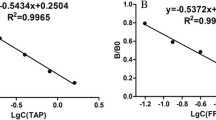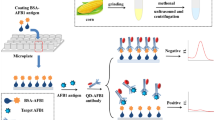Abstract
Cadmium, a toxic heavy metal, poses a significant threat to human health. Currently, the methods for detecting cadmium residue in farm produce need expensive equipment, intensive labor, and much time to finish one detection. In this study, a direct competitive enzyme-linked immunosorbent assay (DC-ELISA) based on a cadmium-chelate-specific monoclonal antibody has been developed. The DC-ELISA showed an IC50 of 2.30 μg/L with a detection limit of 0.20 μg/L for cadmium. The assay has been demonstrated to be highly specific since the monoclonal antibody showed little or no cross-reactivity with all tested metal chelates which include Cd2+, Pb2+, Hg2+, Zn2+, Na+, Ca2+, Fe3+, Mg2+, Mn2+, Cu2+, Al3+, Co2+, Cr2+, Ni2+, Sn2, and K+. The assay showed that a mean recovery ranged from 100.47% to 103.86%, and the coefficients of variations for intra- and inter-assay were 1.73–7.14% and 3.63–6.81%, respectively. Then, several farm produces including wheat flour, apple juice, rice flour, and tea were analyzed for cadmium residue with DC-ELISA and graphite furnace atomic absorption spectroscopy (GFAAS). The correlation coefficient between the DC-ELISA and GFAAS was 0.99. It was demonstrated that the DC-ELISA can be used as a simple and economic method to detect and quantitate cadmium residue in farm produce.





Similar content being viewed by others
References
Musaiger, A. O., Al-Jedah, J. H., & D’souza, R. (2008). Food Control, 19, 854–861. doi:10.1016/j.foodcont.2007.08.011.
McElroy, J. A., Shafer, M. M., Hampton, J. M., & Newcomb, P. A. (2007). The Science of the Total Environment, 382, 214–223. doi:10.1016/j.scitotenv.2007.04.015.
Ansari, M. I., & Malik, A. A. (2007). Bioresource Technology, 98, 3149–3153. doi:10.1016/j.biortech.2006.10.008.
Ceccarini, A., Cecchini, I., & Fuoco, R. (2005). Microchemical Journal, 79, 21–24. doi:10.1016/j.microc.2004.10.020.
Goltz, D. M., Coombs, J., Marion, C., Cloutis, E., Gibson, J., Attas, M., Choo-Smith, L. P., & Collins, C. (2004). Talanta, 63, 609–616. doi:10.1016/j.talanta.2003.12.010.
Liu, G. L., Wang, J. F., Li, Z. Y., & Liang, S. Z. (2006). Chinese Journal of Biotechnology, 6, 877–881.
Blake, D. A., Blake II, R. C., Khosraviani, M., & Pavlov, A. R. (1998). Analytica Chimica Acta, 376, 13–19. doi:10.1016/S0003-2670(98)00437-1.
Khosraviani, M., Pavlov, A. R., Flowers, G. C., & Blake, D. A. (1998). Environmental Science & Technology, 32, 137–142. doi:10.1021/es9703943.
Zhu, X. X., Xu, L., Lou, Y., Yu, H. N., Blake, D. A., & Liu, F. Q. (2007). Journal of Agricultural and Food Chemistry, 55, 7648–7653. doi:10.1021/jf071025l.
Darwish, I. A., & Blake, D. A. (2002). Analytical Chemistry, 74, 52–58. doi:10.1021/ac010510r.
Darwish, I. A., & Blake, D. A. (2001). Analytical Chemistry, 3, 1889–1895. doi:10.1021/ac0012905.
Blake, D. A., Jones, R. M., Blake II, R. C., Pavlov, A. R., Darwish, I. A., & Yu, H. N. (2001). Biosensors & Bioelectronics, 16, 799–809. doi:10.1016/S0956-5663(01)00223-8.
Delehanty, J. B., Jones, R. M., Bishop, T. C., & Blake, D. A. (2003). Biochemistry, 42, 14173–14183. doi:10.1021/bi034839d.
Jones, R. M., Yu, H. N., Delehanty, J. B., & Blake, D. A. (2002). Bioconjugate Chemistry, 13, 408–415. doi:10.1021/bc0155418.
Blake II, R. C., Delehanty, J. B., Khosraviani, M., Yu, H. N., Jones, R. M., & Blake, D. A. (2003). Biochemistry, 42, 497–508. doi:10.1021/bi0267339.
Khosraviani, M., Blake II, R. C., Pavlov, A. R., Lorbach, S. C., Yu, H. N., Delehanty, J. B., et al. (2000). Bioconjugate Chemistry, 11, 267–277. doi:10.1021/bc9901548.
Tawarada, K., Sasaki, K., Ohmura, N., Matsumoto, N., & Saiki, H. (2003). The Japan Society for Analytical Chemistry, 52, 583–587.
Liu, G. L., Wang, J. F., Li, Z. Y., & Liang, S. Z. (2008). Journal of Shanxi University of Science & Technology, 26, 21–26.
Acknowledgment
This study was supported by the Research Foundation of Science and Technology Plan Project in Guangdong Province of China (grant no. 2003C20409) and Science and Technology Project in General Administration of Quality Supervision, Inspection and Quarantine of the People’s Republic of China (grant no. 2004IK062). The authors would like to thank Dr. Hanping Feng for his help and support.
Author information
Authors and Affiliations
Corresponding author
Rights and permissions
About this article
Cite this article
Liu, G., Wang, J., Li, Z. et al. Development of Direct Competitive Enzyme-Linked Immunosorbent Assay for the Determination Cadmium Residue in Farm Produce. Appl Biochem Biotechnol 159, 708–717 (2009). https://doi.org/10.1007/s12010-009-8539-6
Received:
Accepted:
Published:
Issue Date:
DOI: https://doi.org/10.1007/s12010-009-8539-6




